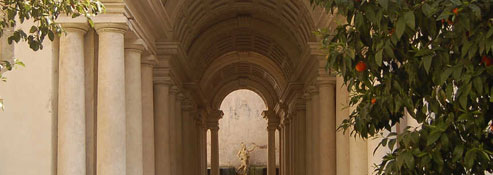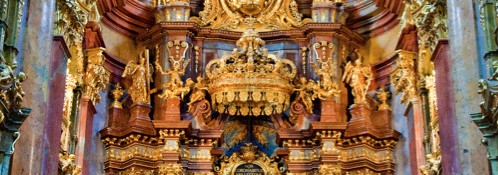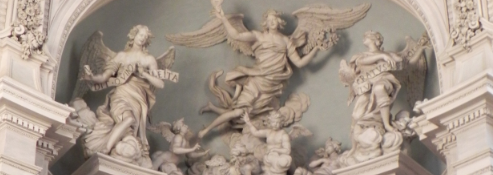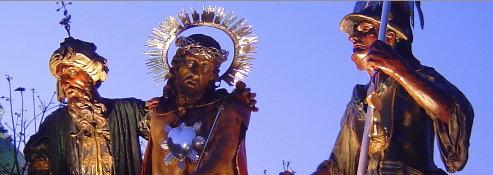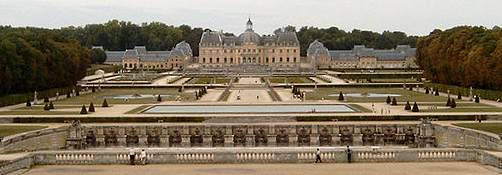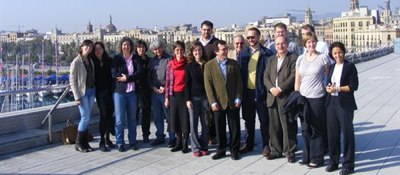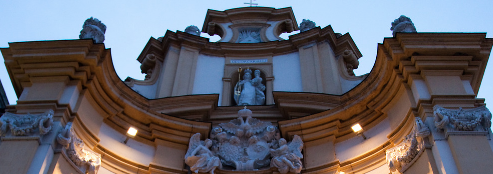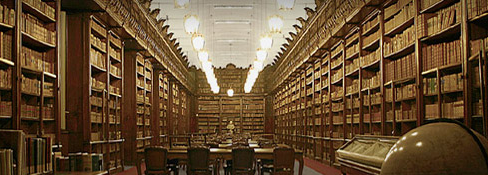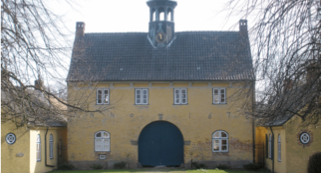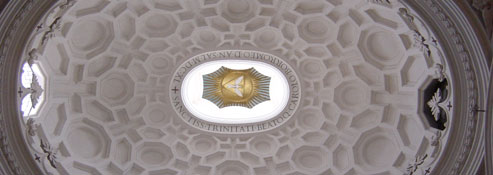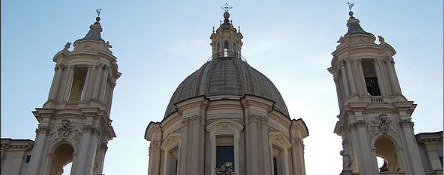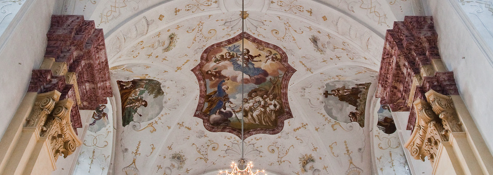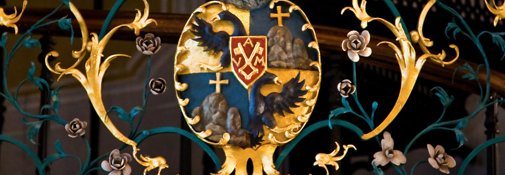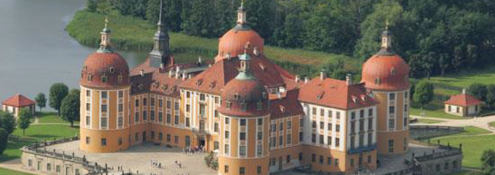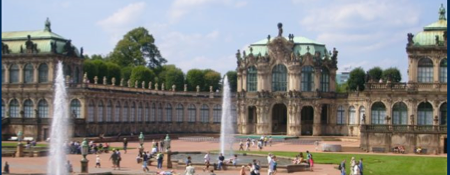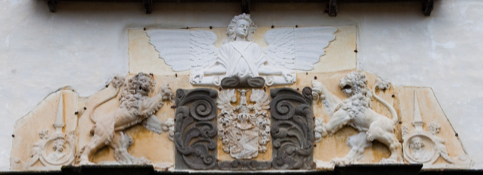Kept for centuries in the Drury Lowe family's rich art collections at their Locko Park residence in Derbyshire, a fascinating portrait of a middle-aged man flaunting a very ornate necklace of shells re-emerged some years ago on the London art market. [fig. 1] [1] Before examining the curious canvas, I had already noticed the singular portrait in an old black and white photograph classified in the Warburg Institute's photographic archive under the category Shells. The man, depicted from the waist up and wearing an austere black tunic with a wide, plain collar, wears a necklace of large Echinofore shells that would appear to hint at a marked interest in malacology or his possible membership of a mysterious brotherhood. Traditionally identified in the old English collection as the Piovano Arlotto [2] (1426-1468), the portrait does not look anything like the XV century Florentine pastor noted for his irresistible theatrics and improvised witticisms, and so dear to popular culture to have been immortalized two centuries later by Baldassarre Franceschini il Volterrano (1611-1689) and Giovanni da San Giovanni (1592-1636) in the celebrated paintings displayed at the Palatine Gallery in Florence and the Corsini Gallery in Rome. [3]
Right from the onset, I was convinced that the presence of the seashell necklace, composed of five specimens of Cassidaria (alias Galeodea) Echinofora and three of the more common "sea whelks" all painted with extreme verism and naturalistic attention, could not be casual and must instead allude to the character's scientific activities, thus providing a clue to his identity. Hence a naturalist of probable Neapolitan origins, because this is how the quality of the painting appeared to me as much for its style and facture, as for the voluminous shells' consonance with the work of Filippo Napoletano (1580-1629) and, later, with that of Paolo Porpora (1617-1673). [fig. 2 and 3] [4] Initially, the most obvious suspect appeared to be Ferrante Imperato (1525 ca.-after 1615) [5], the famous doctor, semplicista [6], botanist and naturalist noted for his natural history museum and his equally valued "experimental" botanical garden, visited by his most illustrious European colleagues, from Carlo Clusio (Charles de l'Ecluse, 1526-1609) to Ulisse Aldrovandi (1522-1605) [7], from French antiquarian Nicolas Claude Fabri de Peiresc (1580-1637) [8] to Lincean academics Federico Cesi (1585-1630) and Johan Faber (1574-1629) [9]. Imperato's celebrated museum - exhibiting both naturalia and artificialia, together with a Portrait Gallery of illustrious scientists - is bequeathed to us by the frontispiece of his summa: the Naturalis Historia published in Naples in 1599. [10] But the portrait of Don Ferrante - known for the two versions kept in the historical section of Pisa's Botanical Gardens and in Rome's Colonna collection [11] - bears no resemblance to the Gentleman of Locko Park. [fig. 4] Besides that, Imperato was quite elderly by 1620-25, the plausible date of the painting in question. Thus we can exclude Imperato and, with him, Giovanni Battista Della Porta (1535-1615), Principe of the Neapolitan branch of the Lincean Academy, who also died in 1615 and was in no way similar; the mysterious character was to be looked for in a younger scientist, possibly Neapolitan, whose research was centred, at least for a while, on the "generation" of marine shells flaunted here as the only characteristic element of the painting. The impenetrable Gentleman of Locko Park must have frequented Rome's Academy of the Linceans [12] and dilettante naturalist Cassiano dal Pozzo (1588-1657) [13], who promoted the first illustrated encyclopaedia of natural history based on experimental science as part of his Museo Cartaceo (Paper Museum), developed simultaneously with Lincean founder Federico Cesi's Erbario Miniato and Syntaxis Plantaria. [14]
After further brainstorming, the solution to the rebus appeared to be Fabio Colonna (Naples 1567-1640). [15] The engraving of the thirty-nine-year old Neapolitan scientist that opens his Ekphrasis in 1606 [16] seems to correspond perfectly, taking into account the difference in age and posture, with the portrait at the centre of our investigation. [fig. 5] The same bump on the forehead, the large, hooked nose, the arched eyebrows, the sunken eyes, the severe expression are clearly visible in both the print and the portrait [17], as is the serious aging due to the quasi fifteen years of hardship suffered between one image and the other. [18] In the earlier print Colonna wears an elegant damask coat worthy of a highly respected gentleman inspired by the above mentioned Portrait of Ferrante Imperato [19]. [fig. 4] The later painted portrait appears, instead, to be closer to that of the erudite Frenchman Nicolas-Claude Fabri de Peiresc (1580-1637) belonging to Cassiano [20] [fig. 6], but for the bizarre chain of seashells the sitter wears as an emblem [21]. The necklace is made up of nine elements: six specimens of the Galeodea echinophora, a seashell found both in the Adriatic and the Tyrrhenian Sea from which a mollusc was extracted and used to make the priceless pigment of the colour purple [fig. 7]; and by three more commonly called "sea snails". A splendid example of the first seashell was painted in tempera and watercolours by Vincenzo Leonardi (1590-after 1646) somewhere between 1623 and 1628 and illustrated in the above mentioned naturalist volumes of the Museo Cartaceo [22]. [fig. 8]
Born in Naples probably in 1567 [23] to Don Girolamo Enrico Signore di Campochiaro and Vittoria de Palma, Fabio Colonna belonged to a Neapolitan branch of the antique Roman family founded by powerful Cardinal Pompeo (1479-1532) - viceroy of Naples from 1530 until his death - and his son Giovanni, born to his morganatic wife, noblewoman Giulia di Fondi. Fabio was educated by his erudite father - lover of letters and collector of paintings, statues and antique coins - in various subjects, including philosophy, mathematics, art, music and jurisprudence.
Graduated in utroque iure in 1589, because of bad health he never practiced law, choosing instead to dedicate himself to naturalistic research with particular regard to botany and the art of the semplici, in order also to find the remedy for his frequent attacks of epilepsy. [24] He thus discovered his vocation to be the study of classical medicine from Hippocrates to Galen, and the research of natural components of pharmacy, which he sought in the manuals by Pliny and Dioscorides [25], personally experimenting the healing faculty of plants and so revealing errors and omissions in the antique texts. He was therefore a supporter and frequent visitor to the botanical gardens created in mid-XVI century Padova (1545), Pisa (1547), Bologna (1567) and Naples itself where, other than Ferrante Imperato's orto, the even richer one created by Giovan Vincenzo Pinelli (1535-1601) was to be found. [26] His meeting with Imperato was crucial for young Fabio, whose intellectual harmony with the older Don Ferrante immediately turned into friendship and intense devotion, thanks to the shared interests in botany and mineralogy, and the joint participation in the new experimental and comparative approach to naturalistic research. Imperato's role as spiritual father to the younger scholar is explicitly declared by Colonna who, already in 1599, contributed to the maestro's Naturalis Historia with several tables of snakes studied and drawn from life. In the Phytobasanos of 1592 - Colonna's first printed work at the age of twenty-five - his debt to Imperato is acknowledged on nearly every page, praising his "museum amplissimum". [27] In this highly regarded volume, published at his own expense, Colonna collects the scientific results of his botanical study carried out around Naples, and illustrated in thirty-five painstakingly detailed engravings drawn by the author himself with as much analytical precision as possible [28]. The accuracy with which Colonna describes every aspect of each plant anticipates by almost thirty years the naturalist's contribution to the invaluable editions promoted by the Lincean Academy and realized thanks to the revolutionary use of the microscope, from the Syntaxis Plantaria patronised by Federico Cesi from 1623-24, to the lavish Melissographia engraved by Matteo Greuter (1564-1638) and offered by the Linceans to Urban VIII (Pope, 1623-1644) in 1625 [29]. As previously underlined by Giuseppe Gabrieli and now by Federico Tognoni, the illustrations in Colonna's books assume a crucial role in the visualization of new discoveries and in the classification of the vegetable and animal worlds he pursued. [30] On top of that, in order to facilitate reference to the classic texts, all the illustrations are labelled with the plant's Latin and Greek names. We may thus imagine that, while conceiving his own painted image, Fabio wanted to provide the observer with a key to its hidden significance, revealing his own identity as a scientist to only the most sagacious colleagues and closest friends. From the Phytobasanos onwards, the Neapolitan experimenter's interests are shown to be far greater in breadth and number than contemporary botanical research and pharmacopoeia. In fact, Colonna extends his naturalistic studies to include the marine flora and fauna to which the essay in the appendix Piscium aliquot Plantarumque Novarum Historia is dedicated, also carefully enriched with appropriate analytical tables. [31] Botanical and zoological arguments, are developed further in the Minus cognitarum stirpium […] Ekphrasis of 1606 [32], a mature text, enhanced with herborization and study trips well beyond the borders of the Neapolitan region undertaken between 1593 and 1606 and made possible by his improved health. [33] In this 1606 volume, in which conchology and marine sciences progressively acquire more body, Colonna shows himself to be completely free of the rigid and conservative legacy of classic tradition, while more than 150 etchings enrich the text, according to the criterion of "omnia fideliter ad vivum delineata", hinted at by the title Ekphrasis. [34]
Thanks to his considerable scientific results and following Federico Cesi's second Neapolitan journey in 1610, Fabio Colonna was invited to join the Academy of Linceans. On January 27th, 1612, he signed the register and so became the eleventh member of Europe's oldest science institute [35] (1603-1630).
In Naples, Fabio became the mainstay ("colonna portante") of the Liceo Napoletano which already included the elderly Principe Giovan Battista Della Porta, celebrated for his De humana physiognomonia (1586), still linked to a magical and alchemical approach to science. [36] His insatiable curiosity and rigorous approach to the libertas investigandi, together with his mineralogical, paleontological and botanical interests, coincided perfectly with those of Federico Cesi and his followers.
The answer to the fascinating rebus connected to the Portrait of Locko Park can be found in an essay written soon after. In the appendix of the second volume of the Ekphrasis, the Minus Cognitarum pars altera, published in Rome by Giacomo Mascardi in 1616 [37], one can find a text of specific pertinence: the De Purpura, a booklet on marine biology that enjoyed notable success amongst its contemporaries, representing one of the founding contributions of modern conchology. [38] The author's effigy in the 1616 volume is the same as the engraving included in the Ekphrasis of 1606 [fig. 5] and much like the portrait at the centre of our investigation. [fig. 1] The book also includes examples of conchae discussed in the text, again "cum iconibus ex aere ad vivum representatis". The essay is dedicated to Cardinal Giacomo Sannesio (1560-1621), a highly shrewd collector and buyer of the first rejected version of the Conversion of Saint Paul by Caravaggio for the Cerasi chapel in Santa Maria del Popolo (1600-1601) [39] and, as told by Fabio, the owner of a rich garden of exotic and Italian plants where the scientist often went to study. [40] A very interesting concidence indeed, that establishes Sannesio as a "naturalist" in the broader sense: precocious and acute buyer of the stunning "naturalist" paintings by Michelangelo Merisi (1571-1610), and proud owner of a fine botanical garden put at the service of the new experimental sciences. As in the case of Cardinal Federico Borromeo, one may notice an interesting coincidence between new sciences and new art, both aimed at the analytical study and faithful illustration of reality. [41]
In De Purpura, Colonna observes and describes in great detail the different species of mollusc from which the highly valued red dye discovered by the Phoenicians and used in the antique world to create colours and dyes was extracted. Fabio quotes Pliny, Aristotle, Vitruvio, Galen, Discoride and, to include the generation immediately preceding his, French zoologist Rondelesio (Guillaume Rondelet, 1507-1566). Fascinated and intrigued by the diverse origins of the pigment in its various shades, Fabio throws himself into the research and cataloguing of all the seashells and relevant molluscs from which it could be extracted, including some terrestrial specimens. He talks of how in ancient times the better appreciated Tiro purple violacea was distinguished from the Tarantino rubra and how nowadays the more common dyes in France were extracted from plants and insects, hence the name vermilion. Describing the fishing locations visited personally on explorative campaigns in the southern Tyrrhenian, Colonna lists twenty types of shells and relative molluscs and indicates the different intensity and shades of the pigments derived, divided into as many chapters complete with illustrated tables. [42] [fig. 9 and 11] He hurls himself into the description of the colours generated from the "Sconciglio spinoso" already identified by Aristotle, a type of muricata shell which was highly abundant along the Neapolitan coastline between Pozzuoli and Capo Miseno [43]; and the Cochlea Ianthina, which Fabio describes as different from Purpurae, but - as he himself observed on the Torre Annunziata coast - still spreading "a beautiful purple colour". [44] [fig. 11] The three smaller shells in the gentleman's collar could thus be identified with this very species - now extinct, but similar to "sea snails" - clearly defined as completely different from the better known Porpore ("del tutto diversa dalle Porpore"). [45]
Thanks to its precision, the De Purpura enjoyed considerable durability and success amongst the experts, gaining Colonna notoriety as a pioneer not only of malacology but paleontology too, dealt with in the appendix De Glossopetris Dissertatio. [46] If Lincean colleague Johan Faber is quick to obtain a copy in 1617 for Cardinal Federico Borromeo (1564-1631), a keen collector and amateur botanist [47], Lincean secretary Francesco Stelluti (1577-1653) is the first to laud it in his Persio tradotto in verso sciolto, the eclectic and encyclopaedic vulgarization of Aulo Persio's satire published in Rome in 1630:
He wrote widely of purple and described his testaceous animal and the Chiocciola Iantina, our Sir Fabio Colonna Linceo, […] by observing not only the exterior heads of the Murice, Porpora and Choclea Iantina, and other even rarer testaceous colours: but also their living animals in great detail. [48]
The 'living animals' referred to by Stelluti and thoroughly studied by Fabio appear to be illustrated both in De Purpura's tables [fig. 9 and 11] and in the aforementioned table of the Museo Cartaceo at Windsor [fig. 8], dating to the mid-Twenties of the XVII century, just like the Locko Park portrait. Notes from de Purpura with passages on the Cochlea Ianthina, accompanied by sketches in his own hand of the Echinofora and other Turbines, also appear in a sketchbook by antiquarian Francesco Angeloni (Terni, after 1559-Rome 1652), a keen collector of shells and other naturalia exhibited in his famous Museo at Porta Pinciana, along with his exceptional anthology of paintings and drawings by Venitian and Bolognese masters. [49] [fig. 19]
In 1667, the booklet was referred to in a more specific context in the Canis Carchariae dissectum caput by Nicola Stenone [50] (Niels Steensen, Copenhagen 1638-Florence 1687), the Danish scientist welcomed in 1666 to the Court of Ferdinand II de' Medici and a member of the Accademia del Cimento; and later in the Vana Speculazione disingannata dal Senso published in Naples in 1670 by the eclectic Sicilian artist, scientist and philosopher Agostino Scilla (Messina 1629-Rome 1700). [51] Both reached interesting conclusions, following the route taken by Fabio on the road to proving the biological origins of marine fossils through experimental analysis. [52] In the splendid figurative repertory of the Vana Speculazione, provided by the erudite Pietro Sante Bartoli (1635-1700) - a friend of Agostino Scilla and himself educated in the "great workshop" of Cassiano dal Pozzo's Museo Cartaceo [53] - we find two elegant engravings of the Echinofora, illustrated in two different examples found in Calabria. [54] [fig. 12]
Finally, it is thanks to the numerous quotes present in the later Recreation dell'occhio e della mente nell'osservation delle chiocciole ("Fulfilment of the eye and mind in observing seashells") published in 1681 by Jesuit priest Filippo Bonanni (1638-1725) - by far the richest illustrated malacological text of the XVII century [55] with "over four hundred and fifty different testaceous figures" - that every possible doubt regarding the identification of the Gentleman of Locko Park as Fabio Colonna is done away with. [56] Bonanni, who frequently quotes De Purpura and confirms Colonna's authority, lingers on the theme of purple pigment, describing and illustrating the wide typology of seashells from which it can be obtained, not only in Phoenicia, but also in Cyprus, Sardinia, Taranto, Cartagine and, in ancient times, even the Adriatic:
It comes from more than just a single species. A group of fifteen shells will appear here, the difference of which one gathers from size, shape, and variety of the essences used for dyes. […]. It yields more types of molluscs, other than the porpore, the name being quite generic, used not only to identify this particular species, but others from which the same pigment is obtained. Many murexes are moist, to be described later, as are whelks and numerous others. I have seen them as beautiful as the amethyst, mixed with pink, in one of those numbered 18 and 19 called Echinofore, brought to me live from the Sea of Nettuno (Class. 3): and Fabio Colonna maintains (Tract. De Purpura) that he found common sea whelks ("chiocciole di mare") at the foot of Vesuvius completely unlike the porpore, but with the same beautiful purple colour. Thus the clothes so dyed are called muricatae and conchyliatae. [57]
It is the Echinofora illustrated in numbers 18 and 19 in Bonanni's Classe Terza dei Testacei Univalvi Turbinati (figg. 13-14) that corresponds to the larger seashells worn by the gentleman in the Locko Park portrait. [58] While the smaller "chiocciola di mare" (common sea whelk) could very well coincide with the same species identified by Colonna "at the foot of Vesuvius" and described as "completely unlike the Porpore", which according to the wording of Pliny, are also specified as Cochlea Ianthina. [59] The reference to the purple contained in the sumptuous necklace worn by the Gentleman of Locko Park is, at this point, quite indisputable and is definitely sealed by the reddish purple thread that links the ten specimens of shells forming the extraordinary collar. [fig. 1]
Furthermore, in the excursus on the origins of purple, Bonanni recalls that: "The celebrated philosopher Zenon of Cizio, before applying himself in Athens to the moral philosophy of Xenophon, was a hoarder and merchant of molluscs" [60]. Thus the fascinating canvas that reemerged in Derbyshire is not just an ephigy of Fabio Colonna alluding to his precise interest in natural history. With his portrait, Don Fabio - "who apart from noble blood has also a noble intellect" [61] - plays on the double register of evidenza and ascendenza: the showy seashell necklace he is wearing points immediately to the species he discovered at the foot of Vesuvius, and to the identification of himself with Zenon of Cizio (333-263 B.C.). As told by Bonnani, after losing everything when the ships transporting his precious murexes were sunk at sea, Zenon, a rich Phoenician merchant of molluscs born in Cyprus, settled in Athens and became a highly renowned philosopher, founder of Stoicism, a doctrine which during the early seventeenth century found many followers among erudite circles in Rome and Naples, and was tolerated by the Jesuits thanks to particular traits of patience, disinterest in terestrial possessions and control of feelings. [62] The bust of Zenon appears, in fact, among Seneca and Socrates in the erudite comment composed by Lincean Johan Faber on Fulvio Orsini's series of Uomini Illustri and once in the collection of Cardinal Ottavio Farnese. [63] [fig. 15]
With subtle symbolic overlap, Fabio Colonna chose to represent himself in the Locko Park portrait as an investigator of the natural world and austere stoic philosopher, a scientist who stoically faced the hardships of an intense life, enduring the adversities of childhood illness, financial difficulties, the hostility of a dominant system and loneliness through the death of numerous friends.
The painting's stoically composed and listless expression aims, however, at underlining not only the sage's virtuous suffering, but also his absolutely rigorous moral and unconditional dedication to science that feature as two fundamental elements shared by the group of Academics gathered around Federico Cesi.
Furthermore, consulting the symbolic manuals of the Baroque Age, it emerges that the ground snail, as much as the shell, alludes to the very soul of the sage freed of its passions, and to the virtue hidden in his chest. [64]
Finally, one adds a level of interpretation both ironic and philosophic: Fabio, vice-Principe of the Neapolitan Lyceum and scientist free of society's conditioning, prefers to immortalize himself by substituting the chivalric necklace of noble origins with the more prosaic necklace of shells that he himself so patiently collected along the Tyrrhenian coast, a symbol of his total devotion to science.
Along with the print of 1606, the circa 1620 oil painting that reemerged at Locko Park appears to be the only surviving image of the Neapolitan scientist's features. In fact, what are missing are the ephigies of Colonna belonging to the series of portraits of scholars and scientists kept in the historic collections of science museums and old botanical gardens throughout Italy and Europe. The portrait at Locko Park is a unique image of its genre, without either precedents or comparisons, a playful and allegorical device directed at the handful of erudite friends who, alone, could have understood the reference to the Lincean's studies of marine biology. Probably an invention aimed at some intrinsic admirer, like Principe Cesi or his Lincean colleague Cassiano dal Pozzo, who joined the Academy in 1622 and who could easily have asked Fabio for a portrait to place in his Gallery of illustrious friends, scholars, scientists and artists. A "talking ephigy", like that of Cesi, Faber, Peiresc, Galileo Galilei and the artists Vouet, Cortona, Poussin, amongst the many exhibited by Cavalier dal Pozzo at his Rome residence. [65]
The neostoic connotations of the portrait lead one to think that the final recipient might have been one of the Linceans closely linked to Colonna by mutual friendship and respect: Principe Federico Cesi who, in his Lynceografo and in a number of letters, exemplified the organization of the new Academy on stoic models and himself, owner of a naturalistic museum rich in shells ("lumache grandi e conchiglie diverse"), which included thirty-five portraits of illustrious men [66]; trusted secretary Francesco Stelluti, one of Fabio's closest friends and first translator of stoic philosopher Aulo Persio's Satires; and above all, doctor and semplicista Johan Faber, himself a disciple of such a doctrine and owner of a naturalist museum. [67] It is no accident that in a 1626 letter to his friend and colleague Giovanni Thuilio, Faber defines the Roman assembly as a "Stoa". [68] Moreover, Faber included Zenone di Cizio alongside stoic colleagues Seneca, Socrates and Aulo Persio amongst the busts of philosophers mentioned in his Commentario on Fulvio Orsini's Uomini Illustri, highlighting his Phoenician origins. [69] [fig. 15]
The attribution of the painting is complex. Its not extraordinary good quality, slight harshness and lack of three-dimensionality in the description of the shells forces us to delete every reference to Filippo Napoletano, who I originally thought could be the author. Pity, because the name of Filippo corresponds perfectly to the context, not only because of the analogy with the two seashells "portrayed" in the Medicean painting [fig. 2], but also because of the strong bonds with the Lincean circle and particularly with Johan Faber, for whom around 1621 he engraved the well-known Scheletrini series of prints drawn in the doctor's paleontological collection at his home by the Pantheon [70]. On top of that, the artist himself, as told by Baglione, also owned a small natural history museum that displayed shells and fossils. [71]
Excluding Filippo, the search should turn its attention towards a different Neapolitan environment. The Caravaggesque and especially Riberesque flavour that distinguishes the Portrait of Locko Park, just as the thick brushstrokes and the coarse facture, point to the circle of Maestro dell'Annuncio ai Pastori. [72] The Spanish Maestro's style reveals itself in the comparison with the Suonatore di Liuto (The Lute Player) recently auctioned in New York [73] [fig. 16], with the Ragazza con la Rosa (Girl with the Rose) from the De Vito collection [74] and with the Filosofi in Meditazione (Philosophers in Meditation) from a private collection recently showcased in Naples. [75] However, the Portrait of Locko Park, does not match their exceptional quality. We might hence have to accept the fact that the Portrait remains anonymous - just like most contemporary Portraits of Scientists - a studio version of the now lost original painted possibly by the Spanish Maestro somewhere between 1616 to 1625. [76] This does not lessen the cultural, historical and symbolic value of the painting. On the contrary, it encourages us to continue looking for its original, which might one day resurface.
The intriguing Echinofore necklace supplies the clue to identifying the whimsical Fabio Colonna and to unveiling a fragment of the crucial empathy developed between the worlds of Science and Art in early XVII century Rome. [77] A trend that will also play its part in Naples in a more incisive manner than previously observed, revealing itself in an exceptional flourishing of Still Life painting. [78] It is a fact that Ferrante Imperato's natural history museum and Vincenzo Pinelli's orto, together with the mineralogical, malacological and botanical interests cultivated by Fabio, fellow Linceans and their European counterparts, contributed to the early development in Naples of a special sensibility in the observation of species. These results are reflected not only in the Two Seashells and Two Cedars portrayed ("ritratte dal naturale") by Filippo Napoletano for Grand Duke Cosimo II de' Medici (1618-1619) [79], but also in the celebrated paintings of "sottoboschi" by Paolo Porpora in which every living being, whether butterfly, flower, fungus, tortoise, snake, lizard or flamingo, is investigated and described in such a way to make it inseparable from the Lincean Academy's investigation of insects, plants, animals, mushrooms and birds of every species. [80] The same is true for the exuberant Still Life "en plein air" painted by Luca Forte in about 1650 [81] [fig. 17] which, quite by surprise, shows the misshapen lemons illustrated by Vincenzo Leonardi in the Museo Cartaceo and engraved in the Hesperides by Giovan Battista Ferrari (1603-1692), the "great book of citrus" edited by Cassiano in 1646, but already in preparation at the start of the 1630s. [82] [fig. 18] All paintings, therefore, that should be associated with the family of the "Specie Ritratte" rather than with the more decorative category of "Natura in posa", according to the principles of the "Pittura Filosofica" ("Philosophical Painting") as expressed by Federico Cesi and Cassiano dal Pozzo. [83]
Images
1. Anonymous Neapolitan Painter, 1620 ca. (Circle of Maestro dell'Annuncio ai Pastori) c. 1620, Portrait of a gentleman with a necklace of shells (here identified as Fabio Colonna), oil on canvas, cm 46 x 35,5, private collection

2. Filippo di Liagno, called Filippo napoletano, Shells, Florence, Museo di Storia Naturale, botanical section, University of Florence

3. Paolo Porpora, Still life with shells and coral, oil on canvas, cm 45 x 33, Galleria Silvano Lodi e Due

4. Anonymous XVII century painter, Portrait of Ferrante Imperato, oil on canvas, cm 83.5 x 69.5, Pisa, botanical garden

5. Anonymous XVII century artist, Engraved Effigy of Fabio Colonna Linceo agde 39, in Fabio Colonna, Minus Cognitarum Stirpium […], Rome, Guglielmo Facciotti, 1606

6. Anonymous XVII century painter, Portrait of Nicolas Claude Fabri de Peiresc, oil on canvas, cm 61 x 51,5, Paris, Chateau de Versailles

7. Specimen of Galeodea Echinofora

8. Vincenzo Leonardi, Echinofora Shell and its murexes, watercolour and black chalk underdrawing on white paper, mm 374 x 239, Windsor Castle, Royal Library inv. 19417, The Property of Her Majesty the Queen

9. Fabio Colonna, Turbo exoticus, Buccinum cum animalis, Buccinum exoticum, ecc, in de Purpura, Rome, Giacomo Mascardi, 1616

10. Fabio Colonna, concha natatilis minima exotica, altera magna, concha utroque latere se colligens, ecc., in de Purpura, Rome, Giacomo Mascardi, 1616

11. Fabio Colonna, Purpura nostras violacea, Cochlea Iantina, in de Purpura, Rome, Giacomo Mascardi, 1616

12. Pietro Santi Bartoli in Agostino Scilla, La Vana Speculazione Disingannata dal Senso, Naples, Andrea Colicchia, 1670, Tav. XV

13. Filippo Bonanni, Recreation dell'Occhio e della Mente nell'Osservation delle Chiocciole…, Classe Terza dei Testacei Univalvi Turbinati, nn. 15-18, Rome 1681 (Rome, Biblioteca Angelica)

14. Filippo Bonanni, Recreation dell'Occhio e della Mente nell'Osservation delle Chiocciole, Classe Terza dei Testacei Univalvi Turbinati, nn. 19-24, Rome 1681 (Rome, Biblioteca Angelica)

15. Anonymous XVII artist active in Rome, Effigy of Zenon, in Johan Faber, In imagines Illustrium ex Fulvii Orsini Bibliotheca, Antwerp 1606

16. Maestro dell'Annuncio ai Pastori, Lute Player, oil on canvas, New York, Private collection

17. Luca Forte, Still Life with lemons, cherries, plums, watermelon and figs in a landscape, oil on canvas, cm 166 x 155, private collection

18. Vincenzo Leonardi, Fingered lemon, watercolour and black chalk underdrawing on white paper, mm 374 x 239, Windsor Castle, Royal Library n. 919379, The Property of Her Majesty the Queen

19. Principi per far la descrittione delle cose contenute nello studio dell'Angeloni in Roma, Venezia, Biblioteca Marciana, Cod. It., Cl. XI, cod. 111 (7410), f. 48

Notes
I wish to thank my friends and colleagues Francesco Solinas, Robert Brodie Booth and Alessandro Ottaviani for reading this text and offering invaluable ideas and advice. I also thank the librarians at Biblioteca Nazionale dei Lincei for their assistance and for allowing me to spend many pleasant hours researching Fabio and his fellows Academicians. This essay is dedicated to all of them and to those who still believe - as Linceans did - in the power of knowledge.
1. Sotheby's London, Old Master Paintings, July 8th, 2004, lot n. 207: Neapolitan School, XVII Century, oil on canvas, cm 46 x 35.5.
2. J.P. Richter, Catalogue of Pictures at Locko Park, Drury Lowe, London 1901, n. 191, p. 79 (ancient inv. 205); and Locko Park and the Drury Lowes, exhibition catalogue, Nottingham, University Art Gallery 1982, n. 49, as Neapolitan School of the XVIIth Century.
3. Cfr. G. Briganti, La "burla del Piovano Arlotto" di Giovanni da San Giovanni, in "Paragone" 39, 1953, pp. 46-49; F. Sottili, Intorno alle "Burle" del Pievano Arlotto, in "Paragone", 735, anno LXII (maggio 2011), pp. 54-62.
4. Cfr. respectively M. Chiarini Teodoro Filippo di Liagno detto Filippo Napoletano (1580-1629). Vita e Opere, Firenze 2007, fig. 42, p. 69 with full bibliography; and N. Spinosa (ed. by), Ritorno al Barocco. Da Caravaggio a Vanvitelli, I-II, exhibition catalogue (Naples, Dec. 12, 2009-April 11, 2010), vol. I, nn. 1.215-1.216, Naples 2009.
5. On Ferrante Imperato, cfr. C. Preti in Dizionario Biografico degli Italiani, vol. 62, 2004, ad vocem, with full bibliography. For his early natural history museum, E. Stendardo, Ferrante Imperato: collezionismo e studio della natura a Napoli tra Cinque e Seicento, in "Quaderni dell'Accademia Pontaniana" n. 31, Napoli 2001.
6. L'arte dei semplici (the art of simples) was the term used at the start of the XVII century to indicate the science and ability to prepare herbal remedies from plants. Carlo Clusio's Rariorum Plantarum Historia, Antwerp, Moretus 1601, was one of the pioneering texts of modern botany. Clusio was director of Vienna's botanical garden (1573-1577 and 1582-1588) and of the one at Leiden from 1593 to his death in 1609. For early flower and plant collectors, cfr. G. Masson, Italian Flower Connoisseurs, in "Apollo" 79, 1968, pp. 164-171.
7. Cfr. G. Olmi, Ulisse Aldrovandi, Scienza e natura nel secondo Cinquecento, Trento 1976; Id., Arte e Natura nel Cinquecento bolognese: Ulisse Aldrovandi e la raffigurazione scientifica, in A. Emiliani (ed. by), Le arti a Bologna e in Emilia dal XVI al XVII secolo, Atti del XXVI Convegno Internazionale di Storia dell'Arte (1979), Bologna 1982; Id., De piscibus: la bottega artistica di Ulisse Aldrovandi, Roma 1993.
8. For Peiresc's trip to Naples in April 1601, cfr. I. Iasiello, Il collezionismo di antichità nella Napoli dei Vicerè, Napoli 2003, p. 8. For young Federico Cesi's visit in 1604, ibid., footnote 29.
9. On early natural sciences and collectors in Italy cfr. G. Olmi, "In essercitio di universale contemplatione, e prattica". Federico Cesi e l'Accademia dei Lincei, in Università, Accademie e Società Scientifiche in Italia ed in Germania dal Cinquecento al Seicento, Bologna 1981, pp. 169-235; Id., Il museo naturalistico in Italia nei secoli XVI e XVII, in "Annali dell'Istituto Storico Italo-Germanico in Trento", VIII, 1982; Id., L'inventario del mondo. Catalogazione della natura e luoghi del sapere nella prima età moderna, Bologna 1992 (Annali dell'Istituto Storico italo-germanico, Monografia 17); Id., Natura-cultura: l'interpretazione del mondo fisico nei testi e nelle immagini, Firenze 2000. See also the important contibutions by L. Tongiorgi Tomasi, Immagine della natura e collezionismo scientifico nella Pisa medicea, in Firenze e la Toscana dei Medici nell'Europa del '500, vol. I, Firenze 1983, pp. 95-108; Ead., Immagine e Natura, exhibition catalogue, Modena, Biblioteca Estense, Modena 1984; Ead., Collezioni e immagini naturalistiche nella Toscana dal Cinque al Settecento. La nascita dei musei scientifici e il rapporto arte-scienza, in "Museologia Scientifica", V, 1988, pp. 31-67; For a history of Italian botanical gardens, cfr. infra, footnote 26.
10. Dell'Historia Naturale di Ferrante Imperato Napolitano Libri XXVIII…..in Napoli per Vitale 1599.
11. For the portrait at Pisa, cfr. F. Tognoni, in L. Tongiongiorgi Tomasi, A. Tosi (eds), Il cannochiale e il pennello. Nuova scienza e nuova arte nell'età di Galileo, exhibition catalogue, Pisa (Palazzo Blu, 9 maggio 19 luglio 2009), Florence 2009 (from now on GALILEO 2009), n. 44, p. 344 (as "Anonymous"), with full bibliography; for the one at Rome, Colonna collection, cfr F. Solinas (ed.), I Segreti di un Collezionista. Le Straordinarie raccolte di Cassiano dal Pozzo, exhibition catalogue, Biella (Museo del territorio biellese, december 16, 2001-march 16, 2002), Rome 2001 (from now on I SEGRETI 2001), n. 23, pp. 119-121 (as "Anonymous german or flemish artist in Naples, last quarter of the XVI century").
12. For a history of the Accademia dei Lincei, see the thorough studies of Giuseppe Gabrieli, now republished in Id., Contributi alla Storia dell'Accademia dei Lincei, I-II, Roma 1989, with full bibliography; I. Baldriga, L'occhio della Lince. I Primi Lincei fra Arte, Scienze e Collezionismo (1603-1630), Roma 2002; D. Freedberg, The Eye of the Linx. Galileo, his Friends, and the Beginnings of Modern Natural History, Chicago and London, 2002; A. Battistini, G. De Angelis, G. Olmi (eds.), All'origine della Scienza moderna. Federico Cesi e l'Accademia dei Lincei (proceedings of the congress) Bologna 2007.
13. For Cassiano dal Pozzo and his Museo Cartaceo see the wide bibliography by Francesco Solinas summarized in the two exhibitions: I Segreti di un Collezionista. Le Straordinarie raccolte di Cassiano dal Pozzo (1588-1657), exhibition catalogue, Rome (Palazzo Barberini, September 29-November 26, 2000), particularly pp. 91-120; and I Segreti 2001, cit, passim, with full bibliography.
14. For a history of the naturalist volumes of the Museo Cartaceo, illustrated from c. 1623 to c. 1628 by Vincenzo Leonardi for Cassiano dal Pozzo and after 1633 kept in his library together with the Erbario Miniato and the Syntaxis Plantaria, a similar group of naturalist volumes patronised by Principe Federico Cesi, cfr. F. Solinas, L'erbario miniato e altri fogli di iconografia botanica appartenuti a Cassiano dal Pozzo, in Il Museo Cartaceo di Cassiano dal Pozzo. Cassiano naturalista, Milan 1989, pp. 52-76; Id., Cassiano dal Pozzo Linceo e alcuni fogli del Museo Cartaceo recentemente acquisiti per le collezioni accademiche, in Sul tesoro messicano & su alcuni disegni del Museo Cartaceo di Cassiano dal Pozzo, Comitato Nazionale per le Celebrazioni del IV Centenario della Fondazione dell'Accademia dei Lincei (ed.), Rome 2007, pp. 93-113; and Id., Osservazione della Natura e "Pittura Filosofica" nella Roma dei primi Lincei, in GALILEO 2009, pp. 225-240. Cfr. also Freedberg 2002, particularly chap. 1 and 8. On the Erbario Miniato at Windsor see now the catalogue edited by L. Tongiorgi Tomasi and F. Garbari.
15. For a profile of Colonna, see Nicola Faraglia, Fabio Colonna Linceo napoletano, in "Archivio Storico per le province napoletane", X, 1885, pp. 665-749 and Gabrieli 1989, cit., II, pp. 1507-17. See also the comprehensive entry in Dizionario Biografico degli Italiani by A. De Ferrari (DBI, vol. 27, 1982, pp. 286-288) with full bibliography; and Nicoletta Morello, La nascita della paleontologia nel Seicento. Colonna, Stenone e Scilla, Milano 1979, pp. 64-91. For the intense epistolary exchanges entertained by Colonna with many of his fellow scientists, cfr. G. Gabrieli, Carteggio Linceo 1603-1630 in "Memorie dell'Accademia dei Lincei. Classe di Scienze morali", fascicoli I-IV, vol. VII, serie VI, Roma 1938-1942 and now fully published in one volume, Rome 1996, ad indicem. The crucial role played by Colonna as an active member of the Academy of Linceans also emerges from the studies of Giuseppe Olmi, La colonia lincea di Napoli, in F. Lomonaco e M. Torrini (eds.), Galileo e Napoli (proceedings of the congress), Naples 1987, pp. 23-58 A. Ottaviani, La natura senza inventario: aspetti della ricerca naturalistica del linceo Fabio Colonna, in "Physis", XXXIV, n.s. (1997), pp. 31-70; and Fredberg 2002, passim.
16. Fabii Columnae Minus cognitarum stirpium …. Ekphrasis…Item de Aquatilibus allisq. Animalibus quibusdam paucis libellus…. Romae, apud Facciottum, 1606.
17. The Portrait of Locko Park can also be compared with the description given by Faraglia of the engraving of 1606 (fig. 5) (FARAGLIA 1885, p. 716): "Fu di gracil membra, aveva il capo grande anzi che no, fronte rotonda, tempia affondate, occhi vivaci, naso grosso rigonfio nel mezzo, guance scarne, mento appuntato" ['His limbs were graceful, his head was rather greater than not, of rounded forehead, lively eyes, large nose swelled at the middle, gaunt cheeks, pointed chin'].
18. GABRIELI 1989, p. 1508; Faraglia 1885, pp. 714-15 and, for the hardship suffered by Fabio, ibid., pp. 675-76, p. 685, p. 687, pp. 696-98, pp. 704-06, pp. 711-13, p. 716; For his will of February 10, 1639, Ibid., pp. 745-749.
19. According to FARAGLIA 1885, p. 716, the plant held by Colonna is a small branch of flowering Columbine ("un ramoscello di aquileggia in fiore"). For the yellow aconite held by Imperato, cfr. Tognoni 2009, p. 344.
20. For a profile of Pereisc and his portrait beloging to Cassiano dal Pozzo, cfr. A. Bresson in I SEGRETI 2000, n. 31, pp. 49-51, as "Anonymous French artist, 1637".
21. For the development of Huomini illustri portrait series between XVI and XVII centuries, cfr. C. Volpi, Dall'Italia dei Principi all'Europa dei letterati. Note in margine alla trasformazione del Museo Gioviano di Uomini Illustri tra Cinquecento e Seicento, in A. Pontremoli (ed.), Il Volto e gli Affetti. Fisiognomica ed espressione nelle Arti del Rinascimento (proceedings of the congress, Turin, November 28-29, 2001) Florence 2003, pp. 39-58, particularly figg. 6, 7, 13, with further bibliography.
22. Windsor Castle, RL 19417. Cfr. H. McBurney, in F. Solinas (ed.), Cassiano dal Pozzo. Atti del seminario Internazionale di Studi, Roma 1989, fig. 19, p. 91. For the Museo Cartaceo, cfr. supra, footnote 13 and Freedberg 2002, passim.
23. Faraglia 1885, cit., pp. 674-75, sets Colonna's birthday in 1567 following the scientist's statement in his 1606 Exphrasis that he started studying Dioscoride's Phu in 1592 "annum vix XXV attigerimus". From what Colonna declares at the moment of entering the Academy of Linceans (January 27, 1612), though, his birth date would have been set in 1571-72: "Ego Fabius Columna Lyncaeus filius Neapolitanus aetatis meae anno 40 salutis 1612 die mensis Januarii 1612 Napoli manu propria scripsi" (cfr. Gabrieli 1989, cit., II, p. 1508). In the engraved portrait included in the 1606 Exphrasis (fig. 9), he is said to be 38 years old ("d'anni trentotto"), confirming 1567 as his year of birth.
24. Faraglia 1885, pp. 675-78. Colonna later declares in his Phytobasanos of 1592 (pp. 113-120), to have found a remedy for his severe illness in valeriana silvestre, Dioscoride's Phu.
25. Nat. Hist. and de Materia Medica respectively. Colonna declares Dioscorides to be his main source, referred to in the ancient manuscript kept at the time in the library of San Giovanni a Carbonara (Dioscorides Napolitanus, Biblioteca Nazionale di Napoli, Codex ex-Vindobonensis Graecus 1; GABRIELI 1989, II, p. 1511). The wonderful illuminations on purple vellum displayed in the precious volume may have aroused Fabio's fascination with the priceless pigment.
26. Cfr. L. Tongiorgi Tomasi, Extra e Intus: progettualità degli orti botanici e collezionismo eclettico tra XVI e XVII secolo, in Il giardino come labirinto della storia (proceedings of the congress), Palermo 1984, pp. 48-57; For Pisa's botanical garden, Ead., with F. Garbari and A. Tosi (eds), Il Giardino dei Semplici, Pisa 2002; Ead., Fiori, giardini, giardinieri, naturalisti e artisti a Roma nella prima metà del Seicento, in S. Marconi (ed.), Scritti e immagini in onore di Corrado Maltese, Roma 1997, pp. 183-189; For Padua's, cfr. C. Bortolotto, L'Orto Botanico di Padova, Roma 2006; For Naples's, A. Ciarallo, L'orto botanico. Origini e fondazione, in "Napoli Nobilissima, 22, 1983, pp. 217-226.
27. Phytobasanos, sive plantarum aliquot historia ….. etiam piscium aliquot, plantarumque novarum historia eodem auctore. …. Ex Officina Horatii Salviani Neapoli MDXCII. Apud Io. Iacobum Carlinum et Antonium Pacem.
28. Colonna preferred the precision of etching to that of woodcut, a cheaper and more commonly used tecnique for book illustration, as seen, for example, in the popular Commentariii a Dioscoride by Pietro Andrea Mattioli (Siena 1501-Trento 1578): Petri Andreae Matthioli Medici Senensis Commentarii, …Venice 1554 (first published with no illustrations in 1544).
29. Urbano VIII Pont. Opt: Max. à Lynceorum Academia Melissographia… Romae 1625. (…) Franciscus Stellutus Lynceus Fabr.is Microscopio observabat. For the use of the microscope ("l'occhialino") in the Syntaxis Plantaria and in the Melissografia, cfr. Solinas in GALILEO 2009 and FREEDBERG 2002, chap.s 1-6-7-8, particularly pp. 151-194 . For the use of the microscope by Fabio Colonna, who fabricated his own lenses, cfr. Gabrieli, Carteggio Linceo 1938-42, passim; Faraglia 1885 (see supra, note 17); MORELLO 1979; F. Tognoni, Nature described: Fabio Colonna and Natural History illustrated, in "Nuncius. Annali di Storia della Scienza" Firenze 2005, n. 20, 2. For the separate illustration of plants' seeds in Fabio's Phytobasanos of 1592, anticipating of almost half a century the seeds sections studied at the microscope by the Linceans and engraved by Cornelis Bloemaert for the De Florum Cultura of the Barberini semplicista and father jesuit Giovan Battista Ferrari (Rome 1633), cfr. Solinas, I SEGRETI 2000, nn. 103-105, pp. 102-103., with bibliography.
30. Tognoni 2005, cit., pp. 347-370, with full bibliography; Id., Segnavia per Fabio Colonna illustratore, in Battistini-De Angelis-Olmi 2007, cit., pp. 395-424. In the same volume, cfr. A. Ottaviani, La parte di Fabio Colonna nel Tesoro messicano dei Lincei, ibid., pp. 367-393. The engravings in Colonna's books have generally been considered autograph (cfr. Gabrieli, Carteggio linceo and FREEDBERG 2002, particularly chap. 8 and 12), while Tognoni prefers to hold the scientist responsible only for the drawings. He also points to an hitherto unknown herbal ("erbario miniato") at Blickling Hall, UK, where specimens of plants are illustrated by Colonna through the technique of typographia naturalis (Tognoni 2005, pp. 359-369, figg. 4,5,7).
31. Piscium aliquot plantarum novarum Historia, in Phytobasanos, 1592, following f. 120, with its own numeration.
32. Minus cognitarum stirpium ….. Ekphrasis. …. Romae, Apud Guillelmum Facciottum, MDCVI.
33. Faraglia 1885, p. 685.
34. Cfr. Ottaviani 2007, cit., p. 368, who underlines Fabio's obsessive attention to detail and considers him a transitional figure between "erudition" and "observation" as stated by Cuvier (cfr. G. Cuvier, Histoire des Sciences Nturelles, tomo X, Parigi 1841, p. 100).
35. Gabrieli 1989, II, p. 1508.
36. For Della Porta, cfr. Gabrieli, Contributi …1989, cit., I, pp. 687-742; e Id, Carteggio Linceo 1996, cit., passim; M. Torrini (ed.), Giovan Battista Della Porta nell'Europa del suo tempo, Proceedings of the Congress (Vico Equense, September 29 - October 3, 1986), Naples 1990; O. Trabucco, Il "corpus" fisiognomico dellaportiano tra censura e autocensura, in I primi Lincei e il Sant'Uffizio: questioni di scienza e di fede, Proceedings of the Congress (Rome, Accademia Nazionale dei Lincei, June 12-13, 2003), Rome 2005, pp. 235-70; For Fabio's role whithin the Neapolitan Lyceo, cfr. Faraglia 1885, cit.; Olmi 1987, cit.
37. Fabii Columnae Lyncei Minus Cognitarum Stirpium pars altera…Romae MDCXVI. Apud Jacobum Mascardum.
38. Fabii Columnae Lyncei Purpura. Hoc est de Purpura ab Animali testaceo fusa, de hoc ipso animali aliisque rarioribus testaceis quibusdam. …Romae MDC.XVI Apud Jacobum Mascardum, with its own numeration (ff. 1-30). In appendix to de Purpura we find the Fabii Columnae Lyncei De Glossopetris Dissertatio (ff. 31-39). For this, cfr. Morello 1979.
39. Cfr. J. A. F. Orbaan, Documenti sul Barocco in Roma, Rome 1920, p. 56, n. 1 and R. Vodret, Il Caravaggio Odescalchi: le due versioni della Conversione di San Paolo a confronto, Milan 2006, with bibliography. For Sannesio's collection, cfr. L. Sickel, Caravaggio, Lanfranco, Reni in der Sammlung Sannesi. Geschicke einer Familie im Spiegel ihren Kunstbesitzes, in "Römisches Jahrbuch der Bibliotheca Hertziana", 38.2007/2008 (2010), pp. 231-295.
40. Cfr. DE PURPURA 1616, dedica.
41.Cfr. Baldriga 2002, pp. 7-35, with bibliography. For Cardinal Borromeo, cfr. P. Jones, Federico Borromeo and the Ambrosiana. Art Patronage and Reform in Seventeenth Century Milan, Cambridge 1993.
42. De Purpura 1616, ELENCHUS.
43. Ibid., p. 11: "(…) Colore tantum obscuriore differt ab aliis vulgaribus aculeatis Purpuris Rondeletii, dictis etiam Sconcigli Spinosi vulgo, sicut & haec etiam Sconciglio appellatur, sed aliis distinctius vulgo, Carosa nomine dicitur, quasi spinis detonsa, & carens; quam copiose Neapoli prope Vrbem in arenosis Piscatores venantur, pulmonum frustulis, iunceis cratibus superimpositis allicientes, ut Aristoteles olfacere consuerit. Hanc litoralem potius in arenosis degentem, quamuis in profundo mari, diceremus Purpuram purpurocaeruleum colorem fundentem (..). Capiuntur etiam prope Misenum Promontorium in Puteolano mari, loco nunc vulgo Mare Mortuum appellato, ubi maris aestus non recipitur, portusque censetur olim ab Agrippa, & Augusto constructus. (…) Plinius Puteolanas Purpuras laudat, an de his intellexerit, aliorum sit iudicium. Capiuntur etiam toto maritimo tractu australi in sinu Formiano olim dicto nunc Molae oppidi (…)".
44. Ibid., pp. 12-14: Cochleae Ianthinae eum Animali exactior icon, & historia. Cap. II: "…nunc autem anno 1609 in oppido dicto Torre della Nuntiata, in Vesuvii montis radice ad maris oram inter Pompeianum, & Stabii ruinas, Maio mense, flantibus occidentalibus, maximoq maris impetu illic aestantibus undis, abiectas inter alias Cochleas multas, ex his adhuc viventes colligi curavimus (…). La Cochlea Ianthina is otherwise described as a shell spreading - as later quoted by Bonanni - "un bel color di Viola simile all'Ametisto".
45. Ibid.: "Ab omnibus Cochlearum terrestrium & maritimarum animalibus reliquis, quas hucusque vidimus, huius animal valde differt (…)"; e infra, Filippo Bonanni, Recreation dell'occhio e della mente…, Roma 1681.
46. Cfr. MORELLO 1979, passim, who focuses mainly on Colonna's De Glossopetris Dissertatio (cfr. DE PURPURA 1616, cit., ff. 31-39), where he belies the legends regarding the origin of these fossils through experimental science.
47. BALDRIGA 2002, cit., p. 22 and footnote 49, from Johan Faber to Cardinal Federico Borromeo, Rome January 28th,1617: "E' fuor anco un'altra opera di certe piante nove et de Purpura, che est animale quod purpuram fundit, pure d'un Lynceo e napolitano Fabio Colonna, che a suo tempo haverà V.S. Ill.ma".
48. Persio tradotto in verso sciolto e dichiarato da Francesco Stelluti Accad. Linceo .. In Roma, appresso Giacomo Mascardi, 1630, p. 16: "Ha scritto de Purpura diffusamente e descritto il suo animale testaceo e la Chiocciola Iantina, il nostro Signore Fabio Colonna Linceo, dottissimo e diligentissimo osservatore delle cose naturali non solo delle piante descritte da lui con mirabil diligenza, et erudizione (…), vedasi il suo libro de Purpura stampato in Roma l'anno 1616" and Ibid., p. 73: "della Murice e della Porpora vedasi Plinio nel lib. 9 cap. 37 e 38, ma al tempo nostr,o come habbiamo detto nella prima Satira, n'ha scritto con pienezza d'osservazioni e di dottrina il nostro Signor Fabio Colonna Viceprincipe in Napoli della nostra Accademia, con osservare non solo le teste esteriori della Murice, Porpora e Cochlea Iantina, et altri più rari testacei: ma anche i loro animali vivi minutamente".
49. Cfr. Venezia, Biblioteca Nazionale Marciana, Cod. It., Cl. XI, cod. 111 (7410): Principi per far la descrittione delle cose contenute nello studio dell'Angeloni in Roma, ff. 31r.-65r., namely ff. 43-48 for the drawings of shells and the discussion of Purpura and Echinofora; f. 46 for his own Purpura shell; and ff. 81r.-82v. for the quotes from Colonna's de Purpura. Other notes are taken from Ferrante Imperato's and Gian Francesco Calceolari's Museums and texts. On this aspect of Angeloni's collection see F. Solinas, Giovani ben intendenti del disegno. Poussin e il Museo Cartaceo, in Poussin et Rome, 1996, pp. 215-240 and V. Carpita, Tra Tasso e Galileo. L'idea bifronte del Museo di Francesco Angeloni, in "Storia dell'Arte" 122/123, 2009, pp. 93-118, with further bibliography.
50. Nicolai Stenonis Elementorum myologiae specimen … Florentiae, ex typographia sub signo Stellae, 1667. For a translation and comment, cfr. Morello 1979, passim, with full bibliography.
51. Agostino Scilla, La Vana Speculazione disingannata dal Senso. Lettera responsiva circa I Corpi Marini, che Petrificati si trovano in vari luoghi terrestri. Di Agostino Scilla Pittore/Accademico della Fucina, detto lo Scolorito…in Napoli , appresso Andrea Colicchia M.DC.LXX (modern edition by M. Segala, Florence 1997). For Agostino Scilla as painter and scientist, cfr. L. Hyerace, Aggiunte ad Agostino Scilla, in "Prospettiva", 93-94, 1999, pp. 200-207, with full bibliography, and Id., Ancora su Agostino Scilla, in "Prospettiva" 126.127, 2007, pp. 156-167; Miriam Di Penta, Agostino Scilla Pittore di Natura Morta. Appunti per un catalogo, in "Paragone" anno LIX, n. 81 (703-settembre 2008), pp. 62-71. For Scilla's own collection of fossils, cfr. S. Di Bella, Agostino Scilla collezionista: la raccolta di fossili in V. Abbate (ed.) Wunderkammer Siciliana, exhibition catalogue (Palermo, Palazzo Abatellis, Nov. 4, 2001- March, 31 2002), Naples 2001, pp. 61-66.
52. Cfr. MORELLO 1979, passim. Colonna's and Scilla's treatises were later republished together in a single volume: De corporibus marinis lapidescentibus…..ex typographia Joannis Zempel prope Montem Jordanum, Romae 1759. The interest of these authors comes from their having rejected traditional classifications of the animal, vegetable and mineral worlds. (Cfr. A. Ottaviani, Il fascino indiscreto delle nature ancipiti: un saggio della "Istoria Naturale" nei secoli XVII e XVIII, in "Giornale critico della filosofia italiana", LXXIX, 2000, pp. 316-369), who also discusses the different positions expressed in Colonna's research on fossils and Principe Federico Cesi's treatise on Metallophyti. The summa of the Lincean knowledge on the subject was Francesco Stelluti's Trattato del Legno Fossile Minerale published in Rome in 1637, where much of Cesi's contribution is to be found. Cfr. F. Solinas, Il Trattato del legno fossile minerale di Francesco Stelluti e i quattro volumi della Natural History of Fossils nelle raccolte della Biblioteca Reale di Windsor, in "Quaderni Puteani" I (Cassiano Naturalista), 1989, pp. 84-94; later published by D. Freedberg and A. C. Scott (eds.), with Francesco Solinas's documentation, The Paper Museum of Cassiano dal Pozzo. Series B: Natural History. 3. Fossil Woods and other Geological Specimens, London 2000. Cfr. Also FREEDBERG 2002, chap. 11.
53. For the contribution of Pietro Santi Bartoli to Scilla's Vana Speculazione, cfr. V. Carpita, Agostino Scilla (1629-1700) e Pietro Santi Bartoli (1635-1700): il metodo scientifico applicato allo studio dei fossili e la sua trasmissione ai siti e monumenti dell'antichità , in "Rendiconti dell'Accademia Nazionale dei Lincei. Classe di Scienze morali, storiche e filologiche", serie IX, vol. XVII. fascicolo 3, 2006, pp. 307-384, with extensive bibliography.
54. Cfr. SCILLA 1670, cit., f. 166, Tavol. XV and Tavol. XVI.
55. For a comprehensive overview cfr. G. Schizzerotto, Il libro naturalistico-malacologico illustrato dal Quattrocento al Settecento, exhibition catalogue (Mantova, Biblioteca Comunale, May 10-31, 1975), Mantua 1975.
56. Filippo Bonanni, Ricreatione dell'occhio e della mente nell'osservation delle chiocciole: proposta a curiosi delle opere della natura, voll. I-II (text and tables), Rome 1681 (modern edition by Sergio Angeletti, Rome 1984). Cfr. particularly vol. I (text), pp. 230-239 and nn. 268-283, for the various typologies of Porpore.
57. Ibid., vol. I, pp. 232-233: "Né da una sola ma da più specie [si può estrarre]. Una squadra di quindici qui apparirà, le differenze delle quali si raccolgono dalla grandezza, dalla forma, e dalla varietà del sugo, che tigne. […]. Anzi si cava da più sorti di Chiocciole, oltre le porpore, essendo questo nome assai generico, e non solamente usurato a significare questa specie particolare, ma altre dalle quali il medesimo colore si ottiene. Succosi ne sono per testimonio di molti Murici, che a suo luogo descriveremo, l'hanno le Buccine, e molte altre. A me è accaduto vederlo bellissimo simile all'Ametisto, mescolato col roseo, in una di quelle del numero 18 e 19 dette Echinofore, portatami coll'Animale vivo dal Mar di Nettuno (Class.3.): e Fabio Colonna asserisce (Tract. De Purpura), haver trovata alle radici del Vesuvio Chiocciola di Mare in tutto differente dalle Porpore, che spargeva un bel color di viola. Quindi le vesti tinte di esso diconsi muricatae e conchyliatae".
58. Ibid., vol. II, Classe Terza dei Testacei Univalvi Turbinati, nn. 16-22 and particularly nn. 18-19. Cfr. supra, note 55
59. DE PURPURA 1616, pp. 12-14, Cochleae Ianthinae eum Animali exactior icon, & historia. Cap. II: "… nunc autem anno 1609 in oppido dicto Torre della Nuntiata, in Vesuvii montis radice ad maris oram inter Pompeianum, & Stabii ruinas, Maio mense, flantibus occidentalibus, maximoq maris impetu illic aestantibus undis, abiectas inter alias Cochleas multas, ex his adhuc viventes colligi curavimus (…). Ab omnibus Cochlearum terrestrium & maritimarum animalibus reliquis, quas hucusque vidimus, huius animal valde differt […]".
60. BONANNI 1681, vol. I, pp. 230-231: "Zenone, quel filosofo sì celebre, prima di applicarsi in Atene alla filosofia morale di Zenofonte, essere stato suo mestiere d'Incettatore, e Mercante di Porpore".
61. STELLUTI 1630, cit., p. 73: "il nostro Signor Fabio Colonna, Viceprincipe in Napoli della nostra Accademia (..) soggetto ch'oltre la nobiltà del sangue ha ancora quella dell'intelletto, che consiste nelle scienze abbracciate da lui con quel fervore, e possedute con quel fondamento, che dimostrano le sue opere già stampate e dimostreranno più quelle che seguiranno a stamparsi".
62. For Rubens's, Elsheimer's and Lincean doctor Johan Faber's friendship and the circulation of neostoicism in early XVII century Rome, cfr. F. Huemer, Rubens and the Roman circle, New Haven and London, 1996; and M. Morford, Stoics and Neostoics. Rubens and the circle of Lipsius, Princeton 1991. For the influence of neostoicism on the Accademia dei Lincei, cfr. Olmi 1992, cit., particularly p. 356, nota 161, and BALDRIGA 2002, IV. Conversazioni Filosofiche: Seneca e la Nuova Scienza, pp. 149-170, with bibliography. For the relationship between new sciences and the Jesuits' Collegio Romano, cfr. A. Battistini, Galileo e i Gesuiti. Miti letterari e retorica della Scienza, Roma 2000.
63. J. Faber, In imagines Illustrium ex Fulvii Orsini Bibliotheca, Antwerp 1606.
64. F. Piccinelli, Mundus Symbolicus, 1657, particularly Cochlea, Lib. VIII, n. 168, f. 520, as in neo-stoic philosopher Justus Lipsius; and Conchylium. Lib. VI, caput XVI, f. 442. I wish to thank Andrea Battistini for pointing out this text to me. The little shells in the necklace could also refer to terrestrial snails from which vermillion was extracted, as described by Rondelet and quoted by Fabio in De Purpura.
65. For the series of Uomini Illustri collected by Cassiano dal Pozzo in his roman house at Via dei Chiavari, cfr. I SEGRETI 2000, particularly pp. 42-51, 59-61 and 68-78. Cfr. also D. Sparti, Le collezioni dal Pozzo. Storia di una famiglia e del suo museo nella Roma seicentesca, Modena 1992. For the concept of "rassomiglianza parlante", cfr. A. Sutherland Harris, Vouet le Bernin et la 'Rassemblance parlante', in S. Loire (ed. by) Simon Vouet, Paris 1992, pp. 192-208.
66. Baldriga 2002, pp. 270-271.
67. Cfr. Ibid., Ritratto di un eclettico: Giovanni Faber Linceo, collezionista e mecenate, pp. 171-233, particularly p. 289, n. 56.
68. Cfr. Olmi 1981 and Olmi 1992, citt.; BALDRIGA 2002, pp. 151-170, particularly pp. 160-163. For the concept of "giardino stoico" and the relation between botanical activity and neo-stoic values, cfr. Ibid., pp. 209-220.
69. Cfr. J. Faber, In imagines Illustrium ex Fulvii Orsini Bibliotheca, Antwerp 1606. Zeno is represented with the bust owned by Orsini and after his death passed on to his Patron, Cardinal Ottavio Farnese. It is today exhibited at Naples's Archeological Museum together with the rest of the Farnese collection of antiquities.
70. Chiarini 2007, cit., nn. 415-435, pp. 476-484.
71. J. Fletcher, Filippo Napoletano's Museum, in "The Burlington Magazine", CXXI, 1979, pp. 649-50.
72. I wish to thank Nicola Spinosa for suggesting the Maestro's name and discussing the Locko Park Portrait with me.
73. Sotheby's New York, Old Master Paintings and Sculpture, January 31, 2013, Lot 49., exh. in Civiltà del Seicento a Napoli, cit., 1984 I, n. 2.147, p. 345.
74. Ibid., n. 2.150, p. 348; cfr. also the Male figure at the mirror at n. 2.146, p. 344.
75. Cfr. N. Spinosa, La Pittura napoletana del Seicento, tavv. 497 and 506 respectively, and RITORNO al BAROCCO 2009, I, nn. 1.29-1.30, pp. 100-101.
76. A precise chronology for the valencian painter is missing. He is traditionally identified with Juan Do, a native of Jàtiva (1601), a disciple of Ribera and his fellow citizen. Do is first documented in Naples in 1626, when he marries Grazia de Rosa, sister of painter Pacecco and acquired daughter of painter Filippo Vitale. It's highly possible, though, that he had arrived in Naples quite earlier, probably not much later than his teacher Ribera, who moved there from Rome in 1616. Ribera acts in fact as a wedding witness to the youngest painter, together with Battistello Caracciolo (cfr. Spinosa, RITORNO al BAROCCO 2009, I, n.1.27, pp. 96-98, with previous bibliography).
77. Cfr G. Olmi, Natura morta e Illustrazione scientifica, in F. Zeri (ed.), La Natura Morta in Italia, I-II, Milano 1989, vol. I, pp. 69-91, with extensive bibliography; and Id., Galileo, le Curiosità e I "celesti spettacoli" in GALILEO 2009, cit., pp. 95-127.
78. Cfr. Anche A. Ciarallo, Le Scienze botaniche a Napoli tra '500 e '700, in "Napoli Viceregno Spagnolo. Una capitale della cultura alle origini dell'Europa moderna (sec XVI-XVII)", tomo I, 2001, pp. 293-310.
79. Chiarini 2007, cit., fig. 42, p. 69; fig. 60, p. 98 and n. 43, p. 273. Although painted for the Medici in Florence, the two paintings are the result of Filippo's patronage by Cardinal del Monte and his association with Lincean scholars in Rome during the years 1614-1617.
80. See, as an example, the two Sottoboschi from the collection of Intesa Sanpaolo (cfr. ZERI, NATURA MORTA 1989, II, figg. 1074-75; and D. Pagano, in M. Gregori (ed.), La Natura Morta in Italia, exhibition catalogue, Florence, Palazzo Strozzi, June 26-October 12, 2006, pp. 198-99); the Louvre Sottobosco with roses, partridge, frogs, owl and ibis (cfr. ZERI 1989, II, fig. 1076); or the Still life with malvarosa, parrots and quince at Capodimonte, Naples (Ibid., fig. 1077). Consider also the relation of Porpora's work with the Uccelliera of Cassiano dal Pozzo (cfr. F. Solinas, L'Uccelliera. Un libro d'arte e di scienza nella Roma dei primi lincei, Firenze 2000) and his paintings by Antonio Cinatti (cfr. I SEGRETI 2000, pp. 104-105, nn. 106-107 and the Red macaw at Nantes Museum p. 116, n. 124); the Flamingo tables in the Museo Cartaceo (F. Solinas, Percorsi puteani: note naturalistiche ed inediti appunti antiquari, in Cassiano 1989, cit., pp. 95-130, figg. 6-7) and the many volumes on Fungi, now dispersed between Paris and Windsor (Freedberg 2002, chap. 8; Solinas 2007; D. Freedberg-D. Pegler (eds), Fungi. The Paper Museum of Cassiano dal Pozzo. Series B: Natural History B, London 2006. On Porpora's work, cfr. Ciarallo 2001, cit, sipra footnote 78.
81. Cfr. RITORNO al BAROCCO 2009, I, n. 1.210, p. 363.
82. G. B. Ferrari, Hesperides sive de malorum aureorum cultura et usu, Roma, Hermanni Scheus, 1646. For Cassiano's role in the production of the book, Cfr. F. Solinas in E. Cropper (ed.), Pietro Testa (1612-1650). Prints and Drawings, exhibition catalogue, Philadelphia 1988, pp. lxxvii-lxxix and notes 75-77, p. lxxxvi; Id., I SEGRETI 2000, pp. 109-114 with full bibliography; FREEDBERG 2002, chap. 1, figg. 1.24-1.26 and 1.41-1.42. The strong bonds of friendship between Cassiano dal Pozzo and Fabio Chigi (1599-1667), later pope as Alexander VII (1655-1667) and Paolo Porpora's leading patron in Rome from around 1650, are certainly to be held responsible for the pouring of Lincean culture in his repertory, and should be considered more influential than his contacts with Dutch painters Otto Marseus von Schriek and Matthias Withoos.
83. For the Cesi's definition, cfr. Baldriga 2002, p.14: "Pittura filosofica. Indirizzo della pittura, e suo studio, non solo a dilettation semplice, il che è vanissimo abuso, ma a giovamento di viva et efficace disciplina e piacer di molta utilità". For the concept of "Pittura Filosofica" as described by Cassiano dal Pozzo, cfr. F. Solinas, La pittura filosofica e la nascita dello "stile Barberini", in S. Schütze (ed.), Estetica barocca, Roma 2004, pp. 241-262 and Id., Osservazione della Natura e "pittura filosofica" nella Roma dei primi lincei, in GALILEO 2009, cit., pp. 225-240.



